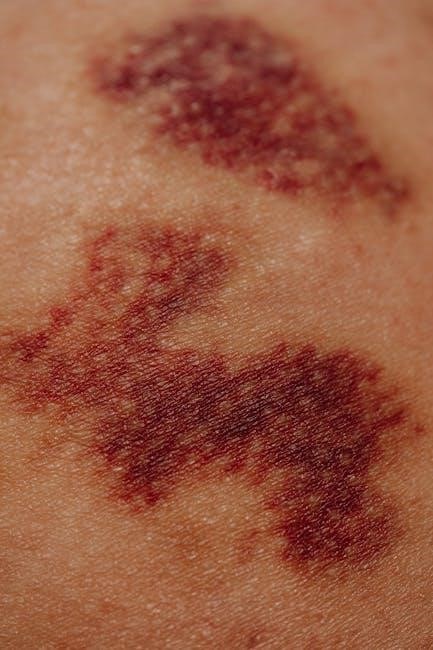Acute Coronary Syndrome (ACS) represents the most severe form of ischemic heart disease, significantly impacting morbidity and mortality. Timely management and diagnosis are crucial for improving patient outcomes.
1.1 Definition and Overview
Acute Coronary Syndrome (ACS) encompasses a spectrum of clinical conditions caused by acute myocardial ischemia, including ST-segment elevation myocardial infarction (STEMI), non-ST-segment elevation myocardial infarction (NSTEMI), and unstable angina. It represents the most common acute presentation of coronary heart disease, often resulting from plaque rupture and subsequent thrombus formation in coronary arteries. ACS is a medical emergency requiring prompt diagnosis and treatment to minimize cardiac damage and improve patient outcomes. Early recognition of symptoms and timely intervention are critical to managing this potentially life-threatening condition effectively.
1.2 Importance of ACS in Cardiovascular Diseases
Acute Coronary Syndrome (ACS) is a leading cause of morbidity and mortality worldwide, significantly impacting cardiovascular diseases. It accounts for a substantial proportion of hospital admissions and is a major contributor to healthcare costs. ACS serves as a critical indicator of coronary artery disease progression, often associated with high-risk clinical outcomes. Early identification and management of ACS are vital to reducing long-term complications and improving quality of life for patients. Its significance underscores the need for comprehensive preventive strategies and standardized treatment protocols to address this major public health burden effectively.
1.3 Scope of the Article
This article provides a comprehensive overview of Acute Coronary Syndrome (ACS), encompassing its pathophysiology, clinical presentation, diagnosis, management, and prevention. It also explores the role of nursing care and future directions in ACS management, ensuring a holistic understanding of the condition.

Types of Acute Coronary Syndrome
Acute Coronary Syndrome (ACS) is categorized into three main types: STEMI, NSTEMI, and unstable angina, each differing in clinical presentation and management approaches.
2.1 ST-Segment Elevation Myocardial Infarction (STEMI)
STEMI is the most severe form of ACS, characterized by a complete blockage of a coronary artery. It results in significant ST-segment elevation on an ECG, indicating transmural ischemia. Patients typically present with severe chest pain, often radiating to the arm or jaw, accompanied by shortness of breath, nausea, or lightheadedness. Prompt diagnosis and reperfusion therapy, such as primary percutaneous coronary intervention (PCI) or fibrinolysis, are critical to restore blood flow and minimize myocardial damage. Timely intervention is essential to improve outcomes and reduce mortality.
2.2 Non-ST-Segment Elevation Myocardial Infarction (NSTEMI)
NSTEMI is a type of ACS characterized by partial coronary artery obstruction, leading to myocardial ischemia without persistent ST-segment elevation on ECG. Symptoms resemble those of STEMI but may be less severe. Diagnosis involves elevated cardiac biomarkers, such as troponin, and ECG changes like ST-segment depression. Immediate treatment includes antiplatelet therapy, anticoagulants, and nitrates. Early invasive or ischemia-guided strategies are recommended to improve outcomes. NSTEMI is less acute than STEMI but still requires prompt medical attention to prevent further cardiac damage.
2.3 Unstable Angina
Unstable angina is a type of ACS characterized by sudden chest pain or discomfort at rest or with minimal exertion, signaling a high risk of imminent myocardial infarction. It occurs due to transient coronary artery occlusion without persistent ST-segment elevation or troponin elevation. Symptoms include prolonged or worsening angina, often radiating to the arm or jaw. Immediate medical attention is crucial, as unstable angina requires aggressive treatment, including antiplatelet therapy, nitrates, and heparin, to stabilize the condition and prevent progression to myocardial infarction. Early invasive assessment is often recommended.
Pathophysiology of ACS
ACS arises from atherosclerosis and plaque disruption, leading to coronary artery occlusion, myocardial ischemia, and necrosis. Inflammation and thrombosis play key roles in disease progression and complications.
3.1 Role of Atherosclerosis
Atherosclerosis is the foundation of ACS, characterized by the buildup of lipid-rich plaques within coronary arteries. These plaques, composed of cholesterol, inflammatory cells, and fibrous tissue, narrow the arterial lumen, reducing blood flow. Stable plaques may cause angina, while unstable plaques are prone to rupture, triggering acute ischemic events. Inflammation and endothelial dysfunction exacerbate plaque instability, leading to clinical manifestations of ACS. Atherosclerosis progression is influenced by modifiable risk factors, making it a central target for prevention and treatment strategies in coronary artery disease.
3.2 Plaque Rupture and Thrombus Formation
Plaque rupture is a critical event in ACS, exposing the lipid-rich core of atherosclerotic plaques to blood. This triggers platelet activation, adhesion, and aggregation, forming a thrombus that obstructs coronary blood flow. The process involves inflammatory mediators and endothelial dysfunction, which destabilize the plaque. Thrombus formation can lead to partial or complete occlusion of the artery, causing ischemia or infarction. This sequence underpins the pathophysiology of ACS and is a key target for therapeutic interventions to restore blood flow and prevent further complications.
3.4 Inflammatory Processes
Inflammation is central to the progression of acute coronary syndrome (ACS). Pro-inflammatory cytokines, such as TNF-α and IL-6, destabilize atherosclerotic plaques, increasing rupture risk. Oxidative stress and endothelial dysfunction, driven by inflammation, further impair blood flow. Chronic inflammation attracts macrophages, worsening plaque instability. Addressing these mechanisms is vital for developing treatments to reduce inflammation and improve ACS outcomes, highlighting the importance of anti-inflammatory strategies in managing and preventing coronary events;
Risk Factors for ACS
Risk factors for ACS include modifiable factors such as smoking, obesity, hypertension, diabetes, and high cholesterol, as well as non-modifiable factors like age and genetics.
4.1 Modifiable Risk Factors
Modifiable risk factors for ACS are lifestyle-related and can be altered to reduce disease risk. These include smoking, hypertension, hyperlipidemia, diabetes mellitus, obesity, physical inactivity, and poor diet. Smoking damages blood vessels, while hypertension and diabetes impair vascular function. Hyperlipidemia promotes plaque formation, and obesity contributes to metabolic syndrome. Addressing these factors through lifestyle changes, such as quitting smoking, exercising regularly, and adopting a healthy diet, can significantly lower ACS risk. Early intervention is crucial for preventing long-term cardiovascular damage.
4.2 Non-Modifiable Risk Factors
Non-modifiable risk factors for ACS are inherent and cannot be changed. These include age, gender, and genetic predisposition. Men are at higher risk than women, particularly after the age of 45, while women’s risk increases post-menopause. A family history of cardiovascular diseases also elevates susceptibility. Ethnicity may play a role, with certain populations showing higher prevalence. Understanding these factors helps identify high-risk individuals for early screening and tailored management strategies to mitigate ACS likelihood.

Clinical Presentation of ACS
The clinical presentation of ACS often includes chest pain, dyspnea, or nausea. Symptoms vary, with women and elderly presenting differently. Prompt recognition is critical for timely intervention.
5.1 Typical Symptoms
The typical symptoms of ACS include chest pain or discomfort, often described as pressure, tightness, or heaviness. This pain may radiate to the jaw, neck, or arm. Patients may also experience shortness of breath, sweating, nausea, or lightheadedness. These symptoms often persist for minutes and may worsen over time. In some cases, especially in women and older adults, symptoms can vary, presenting as indigestion, fatigue, or even silent (asymptomatic) episodes, making early diagnosis challenging. Recognizing these signs is critical for prompt medical intervention.
5.2 Atypical Symptoms
Atypical symptoms of ACS may include indigestion, back pain, or epigastric discomfort, often mimicking gastrointestinal issues. Some patients, particularly women, older adults, or those with diabetes, may experience unusual presentations like fatigue, palpitations, or syncope. These symptoms can overlap with other conditions, leading to delayed recognition. Atypical presentations are associated with higher mortality due to prolonged diagnosis and treatment. Clinicians must maintain a high index of suspicion to identify ACS in these cases and initiate timely interventions.

Diagnosis of ACS
Diagnosis involves clinical assessment, ECG, cardiac biomarkers, and imaging. A comprehensive approach ensures timely detection of ACS, guiding appropriate treatment strategies effectively.
6.1 Clinical Assessment
Clinical assessment is the cornerstone of ACS diagnosis, involving a detailed history, physical examination, and risk factor evaluation. Patients typically present with chest pain, dyspnea, or palpitations. Key considerations include the character, duration, and radiation of pain, along with associated symptoms like nausea or diaphoresis. Physical findings may reveal signs of heart failure or ischemia. A thorough review of modifiable and non-modifiable risk factors, such as hypertension, diabetes, or family history, aids in stratifying likelihood of ACS. This step guides further diagnostic testing and management strategies effectively.
6.2 Electrocardiogram (ECG) Findings
The electrocardiogram (ECG) is a critical tool in diagnosing ACS, often revealing ST-segment elevation, depression, or T-wave inversion. In STEMI, ST-segment elevation is prominent, while NSTEMI may show ST-segment depression or T-wave inversion. Unstable angina can present with similar ECG changes but without persistent ST-segment elevation. Q-waves may indicate previous myocardial infarction. ECG findings help differentiate ACS subtypes and guide immediate management, such as urgent reperfusion therapy. Serial ECGs are essential to monitor dynamic changes and assess response to treatment;
6.3 Cardiac Biomarkers
Cardiac biomarkers, such as troponin and CK-MB, play a pivotal role in diagnosing ACS. Elevated troponin levels are highly specific for myocardial injury, making them a cornerstone in differentiating STEMI from NSTEMI. These biomarkers are released into the bloodstream following cardiac damage, with troponin being the most sensitive and specific marker. Serial measurements are crucial, as levels rise and fall at different intervals post-injury. Accurate interpretation of these biomarkers, alongside clinical and ECG findings, is essential for confirming the diagnosis and guiding management strategies.
6.4 Imaging Techniques
Imaging techniques are vital for assessing cardiac structure and function in ACS. Echocardiography is commonly used to evaluate left ventricular function and identify wall motion abnormalities. Cardiac MRI provides detailed images of myocardial tissue, helping detect infarction and viability. Coronary angiography is the gold standard for visualizing coronary artery stenosis and guiding interventions like percutaneous coronary intervention (PCI). These imaging modalities complement clinical and laboratory findings, enabling precise diagnosis and tailored management strategies for patients with ACS.

Management of ACS
Effective management of ACS involves immediate stabilization, antiplatelet therapy, anticoagulants, beta-blockers, statins, and invasive or ischemia-guided strategies based on patient risk and clinical presentation.
7.1 Immediate Management
Immediate management of ACS focuses on stabilizing the patient, reducing cardiac workload, and restoring coronary blood flow. Oxygen is administered if saturations are low, and nitrates are given for chest pain. Aspirin is promptly administered to inhibit platelet aggregation. In STEMI, urgent reperfusion therapy, either fibrinolysis or primary percutaneous coronary intervention (PCI), is critical; For NSTEMI/unstable angina, an early invasive or ischemia-guided strategy is considered. Pain relief with morphine and beta-blockers to reduce myocardial oxygen demand is also prioritized. Timely intervention is essential to minimize cardiac damage and improve outcomes.
7.2 Medical Therapy
Medical therapy for ACS includes antiplatelet agents, anticoagulants, and medications to reduce cardiac workload. Aspirin and P2Y12 inhibitors (e.g., clopidogrel, ticagrelor) are cornerstone therapies to prevent platelet aggregation. Anticoagulants like heparin or enoxaparin are often added to reduce thrombus formation. Beta-blockers and nitrates are used to decrease myocardial oxygen demand and relieve symptoms. Statins are initiated to lower cholesterol levels. Dual antiplatelet therapy (DAPT) is continued for patients post-PCI, especially with drug-eluting stents. These medications are tailored to individual risk factors and clinical presentation to optimize outcomes and reduce recurrence.
7.3 Invasive Strategies
Invasive strategies for ACS include coronary angiography and percutaneous coronary intervention (PCI). PCI involves angioplasty and stenting to restore blood flow in obstructed arteries. Drug-eluting stents are preferred to reduce restenosis rates. Primary PCI is the gold standard for STEMI patients, aiming to restore blood flow within 90 minutes of first contact. These procedures are critical for improving outcomes in high-risk patients, reducing mortality, and minimizing cardiac damage. Early invasive strategies are particularly beneficial for patients with ongoing ischemia or high-risk features.
7.4 Long-Term Management
Long-term management of ACS focuses on reducing risk factors and preventing future events. This includes lifestyle modifications such as smoking cessation, a heart-healthy diet, and regular exercise. Medications like statins, beta-blockers, and antiplatelet agents are continued to manage cholesterol, blood pressure, and clotting. Regular monitoring of cardiac function and adherence to therapy are essential. Cardiac rehabilitation programs are recommended to improve outcomes and reduce mortality. These strategies aim to enhance quality of life and minimize the risk of recurrent ACS.

Complications of ACS
ACS can lead to serious complications, including arrhythmias, heart failure, and cardiogenic shock. Prompt treatment is crucial to minimize these risks and improve patient outcomes effectively.
8.1 Cardiac Complications
Cardiac complications of ACS include arrhythmias, such as ventricular fibrillation, and heart failure due to reduced left ventricular function. Cardiogenic shock, a severe complication, occurs when the heart cannot pump enough blood. Myocardial rupture, although rare, can lead to tamponade or severe hemorrhage. These complications underscore the importance of early diagnosis and aggressive treatment to preserve cardiac function and improve patient outcomes. Prompt intervention is critical to mitigate these life-threatening conditions effectively.
8.2 Non-Cardiac Complications
Non-cardiac complications of ACS include respiratory failure, stroke, and renal insufficiency. These often arise from systemic inflammation or hypoperfusion. For instance, respiratory failure may occur due to pulmonary edema or pneumonia. Renal dysfunction can worsen due to contrast-induced nephropathy during imaging. Additionally, cerebrovascular events like stroke may occur secondary to emboli or hypotension. Managing these complications requires a multidisciplinary approach, addressing both the underlying cardiac issue and the systemic effects to optimize patient recovery and reduce mortality; Early identification is key to improving outcomes.

Prevention of ACS
Preventing ACS involves lifestyle changes, medical therapy, and risk factor management. Strategies include smoking cessation, healthy diet, regular exercise, and monitoring of cholesterol and blood pressure levels.
9.1 Primary Prevention
Primary prevention focuses on preventing ACS before it occurs by addressing modifiable risk factors. This includes promoting a healthy lifestyle, managing hypertension, diabetes, and high cholesterol, and encouraging a balanced diet and regular exercise. Smoking cessation and stress reduction are also critical. Aspirin therapy, statins, and other medications may be recommended for high-risk individuals. Early identification and intervention in at-risk populations can significantly reduce the incidence of ACS and improve long-term cardiovascular health outcomes.
9.2 Secondary Prevention
Secondary prevention aims to reduce the risk of recurrent ACS events in patients who have already experienced cardiovascular issues. This includes lifestyle modifications, such as dietary changes and exercise, alongside medications like statins, beta-blockers, and antiplatelet agents. Regular monitoring of risk factors and adherence to prescribed therapies are emphasized. Procedures like coronary angioplasty or bypass surgery may be recommended. Patient education on symptom recognition and adherence to treatment plans is crucial to improve long-term outcomes and quality of life.

Current Guidelines and Recommendations
Current guidelines emphasize evidence-based therapies, including early reperfusion for STEMI, dual antiplatelet therapy, and high-intensity statins. Lifestyle modifications and risk factor management are prioritized.
10.1 European Society of Cardiology (ESC) Guidelines
The ESC guidelines for ACS emphasize rapid assessment and management. They recommend immediate ECG, troponin measurement, and risk stratification using tools like the GRACE score. For STEMI, primary PCI within 90 minutes of first contact is advised. Dual antiplatelet therapy with aspirin and a P2Y12 inhibitor is standard. High-intensity statins are recommended for all patients. Early invasive strategy is suggested for high-risk NSTEMI/unstable angina. Coronary angiography should be performed within 24 hours. Secondary prevention includes lifestyle modifications and adherence to prescribed therapies.
10.2 American Heart Association (AHA) Guidelines
The AHA guidelines for ACS focus on early recognition and evidence-based interventions. They recommend immediate ECG and cardiac biomarker assessment to differentiate STEMI, NSTEMI, and unstable angina. Aspirin and P2Y12 inhibitors are first-line therapies, with a loading dose of clopidogrel or ticagrelor. For STEMI, primary PCI within 90 minutes is prioritized. For NSTEMI/unstable angina, a risk-based approach determines invasive vs. conservative strategies. Statins, beta-blockers, and ACE inhibitors are recommended for long-term management. Emphasis is placed on lifestyle modifications and adherence to secondary prevention measures.

Nursing Care in ACS
Nursing care in ACS involves continuous monitoring of vital signs, assessing chest pain, and providing emotional support. Nurses play a crucial role in patient education and adherence to treatment plans.
11.1 Assessment and Monitoring
In acute coronary syndrome (ACS), nursing assessment and monitoring are critical for early detection of complications and improving outcomes. Nurses should perform a thorough initial evaluation, including cardiovascular history, physical examination, and vital sign assessment. Continuous monitoring of electrocardiogram (ECG) for ischemic changes and hemodynamic stability is essential. Regular assessment of chest pain, including severity and characteristics, helps guide treatment. Monitoring cardiac biomarkers, such as troponin levels, and ensuring adequate oxygenation are also key. Nurses play a vital role in identifying high-risk patients and providing timely interventions.
11.2 Patient Education
Patient education is crucial in managing acute coronary syndrome (ACS). Nurses should emphasize lifestyle modifications, such as adopting a heart-healthy diet, quitting smoking, and increasing physical activity. Patients should be educated on medication adherence, including the purpose and potential side effects of prescribed drugs. Teaching recognition of symptoms and the importance of seeking immediate care if they recur is vital. Additionally, stress reduction techniques and follow-up appointment scheduling should be discussed to ensure comprehensive care and improve long-term outcomes.
- Emphasize lifestyle changes and risk factor reduction.
- Highlight medication adherence and symptom monitoring.
- Provide psychological support to address anxiety or depression.
- Encourage regular follow-ups and self-care practices.

Future Directions in ACS Management
Future directions in ACS management focus on personalized medicine, leveraging genetic insights and advanced imaging. Emerging therapies include gene therapy and stem cell interventions to repair cardiac tissue.
Next-generation biomarkers will enable earlier diagnosis and tailored treatments. Telemedicine and wearable devices will enhance monitoring and improve outcomes for ACS patients globally.
12.1 Advances in Diagnostic Techniques
Recent advancements in diagnostic techniques for ACS have significantly improved early detection and accuracy. High-sensitivity troponin assays now enable earlier identification of myocardial damage. Cardiac MRI provides high-resolution imaging of cardiac structures, while AI-driven ECG algorithms enhance diagnostic precision. Additionally, wearable devices allow continuous monitoring of symptoms, facilitating early intervention. Emerging biomarkers like microRNAs further refine risk assessment. These innovations collectively improve patient outcomes through timely and targeted treatments, reducing mortality and morbidity.
12.2 Emerging Therapies
Emerging therapies for ACS focus on innovative approaches to improve outcomes and reduce complications. Antiplatelet and anticoagulant therapies with novel mechanisms are being explored to prevent thrombosis more effectively. Cell therapy, including stem cells, shows promise in repairing damaged myocardium. Gene therapy aims to modify pathways involved in atherosclerosis and inflammation. Clinical trials are also investigating the role of CRISPR technology for precision medicine; Additionally, telemedicine and wearable devices are advancing remote monitoring and early intervention, enhancing long-term management of ACS. These advancements offer hope for better patient care and improved survival rates.
Future advancements in diagnostics and therapies promise better care for ACS patients. A comprehensive approach, combining prevention, timely intervention, and ongoing management, is key to addressing this major cardiovascular burden. Healthcare providers must remain updated on the latest recommendations to deliver optimal care. By integrating these strategies, the prognosis for ACS patients can significantly improve, reducing morbidity and mortality globally.

No Responses